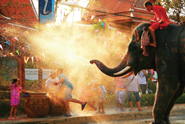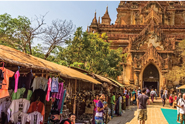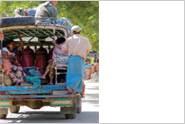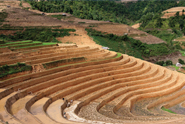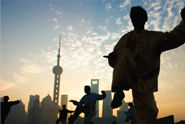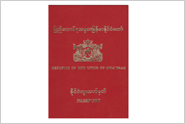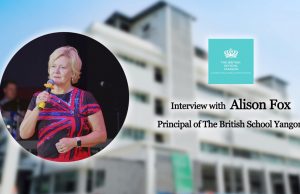Weekend Escape to Bangkok
The prestigious Travel+Leisure magazine didn’t recently adjudge Bangkok as being the best city in the world without good reason. While Bangkok is big, fast and crowded it’s also invigorating and full of life. It appeals to those who want to immerse themselves in Thai life and enjoy some delicious food and fabulous shopping.
Like many Asian cities, Bangkok has many façades and, for some, one is that it’s busy, tiring, hot and much too fast. For others, it’s the madness of Bangkok that’s so appealing. Its other magnetic qualities include the delicious food (both local and a smorgasbord of international cuisines), a wide range of accommodation options from budget to super deluxe, a vast array of shopping opportunities, excellent bars, fascinating tourist attractions, vibrant local markets, improving public transport and cheap flights from within the region.
Sleepless In Bangkok With over 12 million residents in Bangkok there’s not too much that Bangkok doesn’t offer tourists. The city never seems to go to sleep so you can cram in a lot in a few days. There are uniquely Thai attractions, such as Buddhist temples or wats as they are known, tuk tuks (covered motorbikes on steroids for quick trips around the city), Muay Thai exhibitions, artistic handicrafts and the famous massage. First time visitors should visit the Grand Palace, Wat Arun and Wat Phra Kaew down near the banks of the Chao Phraya River, but be warned that it can get very crowded, especially on weekends. You could spend a day here seeing many things Thai, as well as Buddhism, in action.
The Chao Phraya River flows through the city and many of the city’s premier hotels line the river’s eastern banks. One of the best ways to discover this part of Bangkok is to catch boats of the Chao Phraya Express that roar up and down the river stopping at strategic locations along the way. From the city, catch the Bangkok Transit System (BTS) train to Saphan Taksin Station and walk down to Central Pier to catch the ferry. Travel on the ferry for as long as you like (30 minutes is probably adequate), get off and catch another ferry back down the river and get off at places of interest, such as the Grand Palace. Here you will notice long-tail boats moored along the riverbank that are available for charter up the klongs (canals) that radiate from the main river. Floating markets still exist along some back klongs but those that you will be taken to are mostly for tourists so expect to pay tourist prices for souvenirs.
Local Fare Naturally, Thai food is found everywhere with the street food being cheap, tasty and healthy. One of the best fine dining restaurants in which to appreciate authentic Thai food is the Blue Elephant (www.blueelephant.com), which is located in a stately residence opposite Surasak BTS Station. Dine on dishes like mee krob boran and tuna carpaccio. Guests can visit the restaurant to dine or to learn how to cook some exciting Thai dishes. The latter provides a new and interesting activity while on your Bangkok holiday. The school has fully equipped facilities and classes normally commence with an early morning visit to the markets with the chef.
The food court in Siam Paragon Shopping Centre is more upmarket than most others in Bangkok with lots of local and western concepts. One of the great things about food in Bangkok is that international cuisines are well represented, so if you have had enough Thai, check out western styles in Rossini’s (Sheraton Grande Sukhumvit), French at Reflexions (Plaza Athénée Hotel) and Red Sky at 55 Restaurant (Centara Grand and Bangkok Convention Centre at CentralWorld) with its Martini Bar and wine angels who swing from trapeze wires to source wines housed in huge glassed cellars.
Out On The Town
While one shouldn’t travel just to drink, it’s nice to know that beer in Bangkok is cheap (try Singha, Chang and Kloster). Wine isn’t so cheap due to high taxes, so seek out some interesting local wines (yes, made in Thailand!), such as those from PB Estate. Bangkok is one of the greatest Asian cities for a night out with several unique outdoor venues high up in skyscrapers. Check out Sirocco, Distel Sky Bar (in the Dome at State Tower), Vertigo and Grill Moon Bar (Banyan Tree Bangkok) and Red Sky on the 55th floor of the Centara Grand at CentralWorld. All are open to the elements and, on a fine tropical night, the atmosphere is without equal. Sunday evenings are best spent in The Living Room of the Sheraton Grande Sukhumvit for some soothing jazz and their buffet brunch.
Stay In Style
Choose from some of the best hotels in Asia like the luxurious Vie Hotel Bangkok (www. viehotelbangkok.com), which is a member of Accor’s exclusive M Gallery collection. Dine at Vie Dining or enjoy poolside cocktails with some of Bangkok’s best views at Vie 39. Some other excellent luxury hotels are Plaza Athénée (www. plazaatheneebangkok.com) where the spa is an essential stop between shopping forays, and the Sofitel Silom Bangkok (www.sofitel.com) with its exciting restaurant and bar concept V9 Wine Bar & Restaurant located on the rooftop and serving well priced wines to pair with innovative French cuisine. Sofitel guests experience contemporary luxury with a distinctly French art de vivre while the Anne Sémonin Spa within the hotel is one of the most relaxing in the city.
Market Mania
Bangkok has become one of the region’s great shopping paradises with prices offering some of the best value in the region. Young Thai designers set the trend while others find it’s easier to rip off overseas labels. Siam Paragon, CentralWorld, MBK, Siam Square, Siam Discovery Centre and Gaysorn Plaza are all excellent shopping malls located along Rama 1 Road. Chatuchak weekend markets (better known to the locals as “JJ” markets) are a must and, while they get hot and crowded, the bargains make up for any discomfort. With over 8,000 stalls, almost anything and everything is for sale. Catch the BTS to Mor Chit Station and follow the crowds, as they’re all heading to the markets.
While most visitors to Bangkok find it intense and invigorating, it’s also interactive and addictive.

